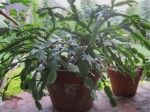 I like to put my house plants outdoors in summer and as the days shorten and the temperatures fall I have to plan for the move back into the house. By planning ahead I can usually minimize the effects of this move. After all, they are going from abundant light, high humidity, high temperatures, and good air circulation to less light, much less humidity, lower temperatures, and relatively lifeless air. No wonder their leaves turn yellow, they wilt, or even die. By easing them into their winter abode they are likely to recover more quickly and settle into their new environment without undo stress.
I like to put my house plants outdoors in summer and as the days shorten and the temperatures fall I have to plan for the move back into the house. By planning ahead I can usually minimize the effects of this move. After all, they are going from abundant light, high humidity, high temperatures, and good air circulation to less light, much less humidity, lower temperatures, and relatively lifeless air. No wonder their leaves turn yellow, they wilt, or even die. By easing them into their winter abode they are likely to recover more quickly and settle into their new environment without undo stress.
When the temperatures inside and outside are about equal I begin the preparations. I try to do this before the outdoor temperatures get below 50 at night because some of the plants will be hurt by lower temperatures. Sometimes this gets away from me and I have to take the plants in at night and put them outside again during the day. This is a good time to take cuttings of geraniums, begonias, impatients and other plants I want to propagate. Here are my 5 steps for moving plants indoors in the fall.
1. In order to clean the pots and remove unwanted bugs I soak them in lukewarm water for 15 minutes.
2. Over the course of a week I move the plants to shadier and shadier locations so they can gradually adjust to the decrease in light that they will have indoors. No matter how much light they get indoors it will not be as much as they got outdoors so they need time to change their food manufacturing and metabolism.
3. When I bring the plants indoors I try to place them in optimal light conditions; most plants do best with bright indirect light. I always use a tray under each plant but sometimes this is not enough and condensation will occur under the tray and damage the floor or table underneath the tray. I have successfully used coasters and hotpads under trays; anything to lift the tray off the surface.
4. Some plants need high humidity and I place them on a tray of gravel with water added up to the surface of the gravel. Moving these plants indoors before turning on the furnaces help them adjust.
5. When the soil on the surface of the pot dries I water the plant but not before; the plants need much less water than if they were in the garden since they will not lose water as quickly indoors.
Notice that the fertilizer stays on the shelf until spring after the plants have rested and are ready to grow again.
In spite of my best efforts, some plants will drop leaves or show other signs of stress. Usually the stress is be temporary and the plant recovers. Extra water or fertilizer is NOT the solution, time and patience is.